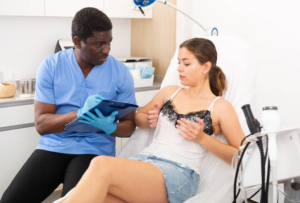Recovery Tips And Aftercare For Breast Augmentation Surgery

Considering breast augmentation? Perhaps you’re also researching the cheapest state for breast augmentation to ensure you get the best value for your money. Understanding recovery and aftercare is crucial for smooth healing regardless of where you choose to have the procedure. This brief guide offers essential tips for your post-surgery period. Following your surgeon’s instructions on wound care, such as maintaining clean and dry incision sites, changing dressings, and adhering to prescribed medications, is vital. You may feel discomfort, but your surgeon will provide pain management solutions. Rest and avoid strenuous activities during the initial weeks to promote proper healing. These tips can pave the way for a successful recovery.
Initial Recovery Tips
After your breast augmentation surgery, you should expect a few things during your initial recovery. You may experience some pain, swelling, and bruising in the first few days, but this is normal and can be managed with pain medication.

It’s important to follow your surgeon’s instructions for post-surgery care, which may include wearing a compression bra and avoiding strenuous activities for a few weeks.
What to Expect
During the recovery period, you’ll experience a range of sensations as your body adjusts to the changes from the breast augmentation surgery. Feeling discomfort, swelling, and bruising in the first few days after the surgery is normal.
Your breasts may feel tight and sensitive, and you may have difficulty performing specific movements or activities. Following your surgeon’s instructions and taking any prescribed pain medications is essential to help manage the discomfort.
Over time, these sensations will gradually subside, and you will start to notice the surgery results. Being patient and giving your body the time it needs to heal correctly is crucial.
Remember to avoid strenuous activities and lifting heavy objects during the initial recovery period. By following these guidelines, you can expect a smoother recovery and achieve the best possible outcome from your breast augmentation surgery.
Overview of Post-Surgery Care
Throughout your healing process, it’s essential to carefully follow the instructions provided by your surgeon to ensure your body adjusts properly to the changes made.
After your breast augmentation surgery, you will be given specific guidelines on how to care for your incisions, manage any discomfort, and prevent complications. This may include wearing a supportive bra, avoiding strenuous activities, and taking prescribed medications as directed.
You will also need to attend follow-up appointments with your surgeon to monitor your progress and address any concerns. It’s crucial to communicate openly with your surgeon during this time and ask any questions you may have.
Adhering to the post-surgery care instructions and staying in close contact with your surgeon can optimize your recovery and achieve the best possible outcome.
Diet and Nutrition After Surgery
After breast augmentation surgery, paying attention to your diet and nutrition is essential for optimal healing.

You should focus on consuming foods that promote healing, such as those rich in protein, vitamins, and minerals.
Additionally, it’s crucial to avoid certain foods that can potentially delay the recovery process.
Nutritional Intake for Healing
Focusing on nourishing your body with a balanced diet rich in vitamins and minerals is essential to aid in the healing process after breast augmentation surgery. Your nutritional intake plays a crucial role in promoting proper healing and reducing the risk of complications.
Make sure to include plenty of fruits and vegetables packed with antioxidants that can help boost your immune system and promote tissue repair. Additionally, incorporate lean protein sources like chicken, fish, and tofu to give your body the necessary building blocks for tissue regeneration.
Don’t forget to include whole grains, such as brown rice and quinoa, which are high in fiber and can aid in digestion. Lastly, stay hydrated by drinking plenty of water throughout the day. Proper hydration is vital for maintaining optimal bodily functions and supporting the healing process.
By following these guidelines, you can optimize your nutritional intake to support a speedy and successful recovery after breast augmentation surgery.
Specific Foods to Avoid and Include
Now that you know about the importance of nutritional intake for healing after breast augmentation surgery, let’s dive into the specific foods you should avoid and include in your diet.
It’s crucial to steer clear of foods that can hinder your recovery process, such as processed snacks, high-sodium meals, and sugary treats. Instead, focus on incorporating nutrient-dense foods into your meals, like lean proteins, fresh fruits and vegetables, whole grains, and healthy fats.
These foods can provide the necessary vitamins, minerals, and antioxidants to promote healing and boost your immune system. By making smart choices in your diet, you can support your body’s recovery and achieve optimal results from your breast augmentation surgery.
Tips for Physical Activity
After undergoing breast augmentation surgery, gradually reintroducing physical activity into your routine is essential.

Exercising after different types of breast augmentation surgery can help improve blood circulation, promote healing, and prevent complications such as blood clots. However, it’s crucial to use proper techniques for both rest and physical activity to avoid strain or injury to your body.
Exercising After Surgery
Exercising might initially feel challenging and uncomfortable, but it’s important to gradually reintroduce physical activity after breast augmentation surgery to regain strength and confidence.
Start with light exercises such as walking or gentle stretching to improve blood circulation and prevent blood clots.
As you start feeling more comfortable, you can slowly increase the intensity and duration of your workouts.
Remember to listen to your body and not push yourself too hard.
Avoid exercises that strain your chest muscles, such as push-ups or weightlifting, until you’re fully healed.
It’s crucial to wear a supportive sports bra during exercise to provide proper support and minimize discomfort.
If you experience any pain or discomfort during or after exercising, it’s essential to take a break and consult with your surgeon.
By gradually incorporating exercise into your routine, you can promote a faster recovery and achieve optimal results.
Proper Techniques for Rest and Physical Activity
Take the time to rest and engage in physical activities that support your body’s healing process and overall well-being.
After breast augmentation surgery, it’s important to prioritize rest and give your body the time it needs to recover. This means avoiding strenuous activities and heavy lifting for at least six weeks.
However, light walking is encouraged as it promotes blood circulation and can help prevent complications such as blood clots.
When engaging in physical activities, it’s crucial to use proper techniques to protect your healing incisions and implants. Avoid any exercises that put pressure on your chest or involve repetitive arm movements.
Instead, focus on low-impact exercises like gentle stretching, yoga, and light cardio.
Listen to your body and gradually increase your activity level as you heal.
Remember, proper rest and physical activity are key components of a successful recovery after breast augmentation surgery.
Important Considerations Post-Surgery
After your breast augmentation surgery, it’s crucial to prioritize your follow-up care. This includes attending all scheduled appointments with your surgeon to ensure proper healing and address any concerns or complications.

Additionally, it’s essential to understand and adhere to the limitations placed on physical activity during the recovery period.
Lastly, being aware of and recognizing warning signs of complications, such as excessive pain, bleeding, or infection, is vital for your overall well-being and successful recovery.
Follow-Up Care
During the follow-up care process, it’s essential to communicate any concerns or questions you may have with your surgeon to ensure a smooth and successful recovery.
Your surgeon will schedule regular follow-up appointments to monitor your progress and address any issues that may arise.
These appointments allow you to discuss any discomfort, swelling, or changes in sensation you may be experiencing.
Your surgeon will also examine your incisions and breasts to ensure proper healing.
It’s essential to be honest and open during these appointments, as your surgeon can provide guidance and reassurance to help you recover.
Additionally, it’s important to adhere to any instructions provided by your surgeon regarding medications, dressings, and activities to promote healing and reduce the risk of complications. This is an integral part of reaping the benefits of breast augmentation post-surgery.
By actively participating in follow-up care, you can ensure that any potential problems are addressed promptly, leading to a successful and satisfying outcome.
Limitations and Warning Signs of Complications
Be aware of the limitations and warning signs of complications to ensure a safe and successful healing process after your procedure.
It is important to remember that during the recovery period, you may experience some limitations in your daily activities. Avoid heavy lifting, strenuous exercise, and any activities that strain your chest muscles for at least a few weeks.
Additionally, be on the lookout for warning signs of complications such as excessive swelling, severe pain, abnormal bruising, or a high fever. If you experience any of these symptoms, contact your surgeon immediately, as they could indicate an infection or other complications.
It’s better to be cautious and seek medical advice rather than ignoring potentially serious issues.
Conclusion
In conclusion, now that you’ve undergone breast augmentation surgery, taking care of yourself during recovery is essential.
Follow the initial recovery tips provided by your surgeon, such as wearing a supportive bra and avoiding strenuous activities.



